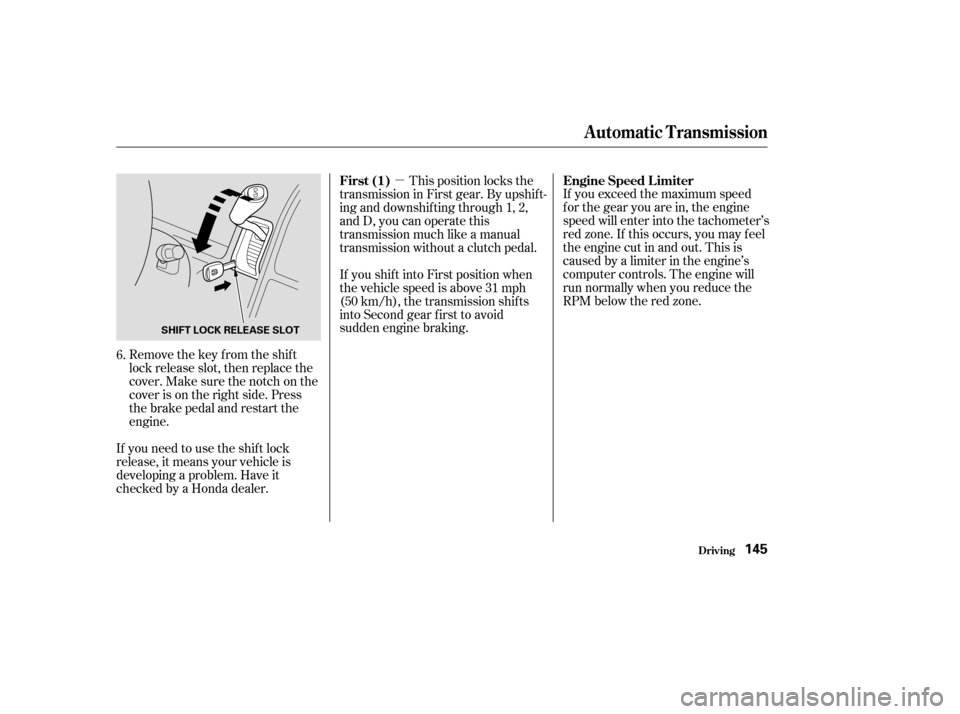Page 132 of 256
Remove the dipstick again and
check the level. It should be
between the upper and lower
marks.
If it is near or below the lower mark,
see on page . Look at the coolant level in the
radiator reserve tank. Make sure it is
between the MAX and MIN lines. If
it is below the MIN line, see
on page f or
inf ormation on adding the proper
coolant. Refer to
on page f or
inf ormation on checking other
items in your Honda.
4. 173 176167
Service Station Procedure
Bef ore Driving
A dding Oil Engine Coolant Check
A dding
Engine Coolant Owner’s Maintenance
Checks
128
UPPER MARK
LOWER MARK MAX RESERVE TANK
MIN
Page 133 of 256
Always maintain your vehicle
according to the maintenance
schedule. See(see page
).
an underinf lated tire
causes more ‘‘rolling resistance,’’
which uses f uel.
The build-up of snow or mud on
your vehicle’s underside adds
weight and rolling resistance.
Frequent cleaning helps your f uel
mileage and reduces the chance of
corrosion.
Drive moderately. Rapid
acceleration, abrupt cornering and
hard braking use more f uel.
Always drive in the highest gear
possible. The air conditioning puts an extra
load on the engine which makes it
usemorefuel.Usethefresh-air
ventilation when possible. Combine several short trips into
one. Try to maintain a constant speed.
Everytimeyouslowdownand
speed up, your vehicle uses extra
fuel.Usethecruisecontrolwhen
appropriate.
167
For example,
Fuel Economy
Bef ore Driving
Improving Fuel Economy
Owner’s
Maintenance Checks
129
Page 141 of 256
Check that any items you may be
carrying with you inside are stored
properly or f astened down
securely. Visually check the tires. If a tire
looks low, use a gauge to check its
pressure. Check that the hood, tailgate and
hatch glass are f ully closed. Make sure all windows, mirrors,
and outside lights are clean and
unobstructed. Remove f rost, snow,
or ice.
Youshoulddothefollowingchecks
and adjustments bef ore you drive
your vehicle.
Check the seat adjustment (see
page ).
Check the adjustment of the
inside and outside mirrors (see
page ).
Check the steering wheel
adjustment (see page ).Make sure the doors and tailgate
are securely closed and locked.
Fasten your seat belt. Check that
your passengers have f astened
their seat belts (see page ).
When you start the engine, check
the gauges and indicator lights in
the instrument panel (see page
).
1.
2.
3.
4. 5.
6.
7.
8.
9.
10.
77
89 68 15
55
Driving Guidelines
Driving
Preparing to Drive
137
Page 149 of 256

�µIf you exceed the maximum speed
f or the gear you are in, the engine
speed will enter into the tachometer’s
red zone. If this occurs, you may f eel
the engine cut in and out. This is
caused by a limiter in the engine’s
computer controls. The engine will
run normally when you reduce the
RPM below the red zone.
This position locks the
transmission in First gear. By upshif t-
ing and downshif ting through 1, 2,
and D, you can operate this
transmission much like a manual
transmission without a clutch pedal.
If you shif t into First position when
the vehicle speed is above 31 mph
(50 km/h), the transmission shif ts
into Second gear f irst to avoid
sudden engine braking.
Remove the key from the shift
lock release slot, then replace the
cover. Make sure the notch on the
cover is on the right side. Press
the brake pedal and restart the
engine.
If you need to use the shif t lock
release, it means your vehicle is
developing a problem. Have it
checked by a Honda dealer. 6. Engine Speed L imiter
First (1)
Automatic Transmission
Driving145
SHIFT LOCK RELEASE SLOT
Page 151 of 256

Your Honda is equipped with disc
brakes at all f our wheels. A power
assist helps reduce the ef f ort needed
on the brake pedal. The ABS (on
vehicles equipped with ABS) helps
you retain steering control when
braking very hard.
Resting your f oot on the pedal keeps
the brakes applied lightly, builds up
heat, and reduces their ef f ectiveness.
It also keeps your brake lights on all
the time, conf using drivers behind
you.Constant application of the brakes
when going down a long hill builds
up heat and reduces their ef f ective-
ness. Use the engine to assist the
brakes by taking your f oot of f the
accelerator and downshif ting to a
lower gear.
Check your brakes af ter driving
through deep water. Apply the
brakes moderately to see if they f eel
normal. If not, apply them gently and
f requently until they do. Be extra
cautious and alert in your driving.
The hydraulic system that operates
the brakes has two separate circuits.
Each circuit works diagonally across
the vehicle (the lef t-f ront brake is
connected with the right-rear brake,
etc.). If one circuit should develop a
problem, you will still have braking
at two wheels.
Braking System
Driving
Braking System Design
147
Front
Page 161 of 256

Your Honda can be towed behind a
motorhome at legal highway speeds
up to 65 mph(100 km/h). Do not
exceed 65 mph(100km/h).
Otherwise, severe transmission
damage will occur. To avoid damage
to the 4WD system, it must be towed
with all f our wheels on the ground
(f lat towing).
When purchasing a tow bar, make
sure you select a reputable
manuf acturer and installer. Follow
the manufacturer’s attachment
instructions caref ully.Perf orm the f ollowing procedure
everyday immediately bef ore you
begin towing. Otherwise severe
automatic transmission damage will
occur.
Check the transmission f luid level
(see page ).
Start the engine.
Press on the brake pedal. Move
the shif t lever through all its
positions.
ShifttoD,thentoN.Letthe
engine run f or three minutes, then
turn it off.
Leave the ignition switch in
ACCESSORY (I) so the steering
wheel does not lock. Make sure
the radio and any items plugged
into the accessory power sockets
are turned of f so you do not run
down the battery. If you tow more than 8 hours in one
day, you should repeat the above
procedure at least every 8 hours
(when you stop f or f uel, etc.)
Release the parking brake. 179
Do not overf ill.
Driving
Towing Your Vehicle Behind a Motorhome
Ext ended T owing
157
NOTICE:
NOTICE:T he steering system can be
damaged if the steering wheel is locked.
Leave the ignition switch in Accessory
(I), and make sure the steering wheel
turns f reely bef ore you begin towing.
Failure to f ollow the above
instructions exactly will result in severe
automatic transmission damage. If you
cannot shif t the transmission or start
the engine, your vehicle must be
transported on a f lat-bed truck or
trailer.
Page 167 of 256

This section explains why it is
important to keep your vehicle well
maintained and how to f ollow basic
maintenance saf ety precautions.
This section also includes
Maintenance Schedules f or normal
driving and severe driving conditions,
a Maintenance Record, and instruc-
tions f or simple maintenance tasks
you may want to take care of
yourself .
If you have the skills and tools to per-
f orm more complex maintenance
tasks on your Honda, you may want
to purchase the Service Manual. See
page f or inf ormation on how to
obtain a copy, or see your Honda
dealer.......................
Maintenance Saf ety .164
.................
Maintenance Schedule . 165
....................
Maintenance Record .170
..............................
Fluid Locations .172
........................
Adding Engine Oil .173
.........
Changing the Oil and Filter . 174
..............................
Engine Coolant .176
....................
Windshield Washers .178
.......................
Transmission Fluid .179
................
Brake and Clutch Fluid . 181
....................
Power Steering Fluid . 182
....................................
Hood Latch .182
.............................................
Lights .183
.......................................
Seat Belts .187
.....................................
Floor Mats .188
..................
Dust and Pollen Filter . 188
.................................
Wiper Blades .189
...............................................
Tires .190
...................
Checking the Battery . 196
.............................
Vehicle Storage .197
243
Maintenance
Maint enance163
Page 171 of 256

�µ�µ �µ
�µ
�µ �µ �µ
Youshouldcheckthefollowing
items at the specif ied intervals. If
you are unsure of how to perf orm
any check, turn to the appropriate
page listed. Engine oil level Check every
time you fill the fuel tank. See
page .
Engine coolant level Check the
radiator reserve tank every time
you f ill the f uel tank. See page .Tires Check the tire pressure
monthly. Examine the tread f or
wear and foreign objects. See page
.
Windshield washer f luid Check
the level in the reservoir monthly.
If weather conditions cause you to
use the washers f requently, check
the reservoir each time you stop
f or f uel. See page .
Brakes Check the f luid level
monthly. See page . Automatic transmission Check
the f luid level monthly. See page . Lights Check the operation of
the headlights, parking lights,
taillights, high-mount brake light,
turn signals, brake lights, and
license plate light monthly. See
page .
127
128
178
179 183
190
181
Maintenance Schedule
Maint enance
Owner’s Maintenance Checks
167